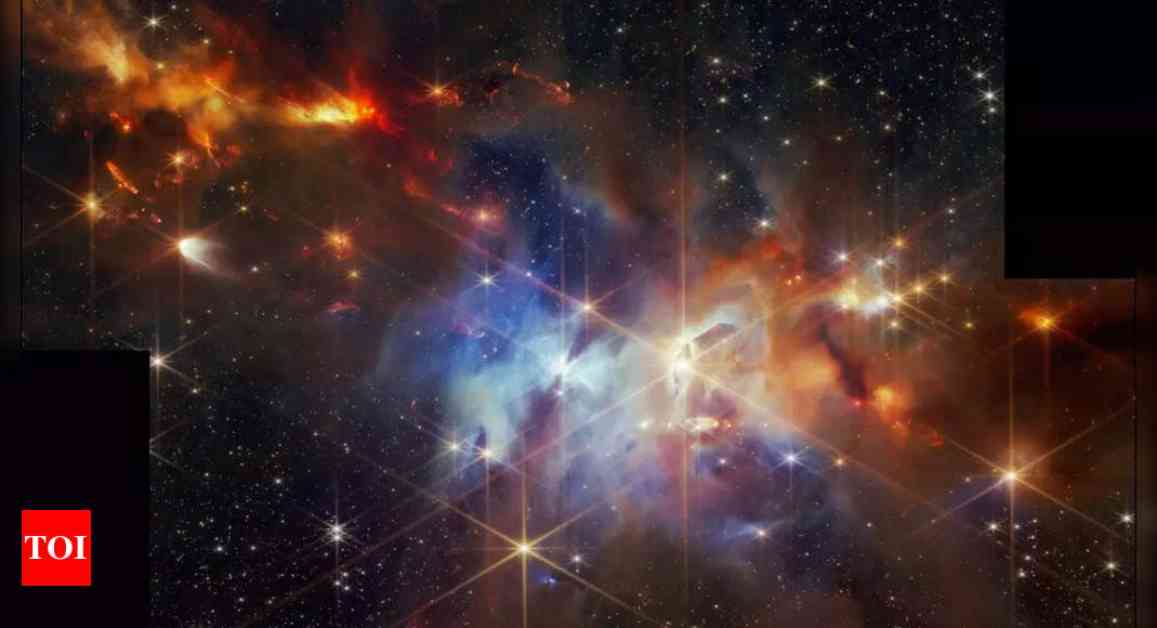NASA’s James Webb Space Telescope has achieved a groundbreaking discovery in its observation of the Serpens Nebula, shedding new light on the enigmatic birth of stars. On June 20, 2024, the telescope captured a remarkable phenomenon: aligned protostar outflows from baby stars. This unprecedented image showcases jets of gas emanating from these newborn stars, all oriented in the same direction. The alignment of these outflows, a previously unseen phenomenon, provides a unique view of the early stages of star formation.
Webb’s advanced infrared capabilities played a crucial role in unveiling these hidden details within the Serpens Nebula. By penetrating dense cosmic dust, the telescope was able to reveal the intricate features of these protostellar outflows with exceptional clarity, offering new insights into the dynamic processes of stellar birth.
A New Era in Astronomy
The latest image captured by Webb’s near-infrared camera unveils the complex details of the Serpens Nebula, a dense region of star formation located just 1,300 light-years from Earth. Within this region lies approximately 100,000 stars, all packed within a relatively small span of a few tens of light-years. The telescope’s ability to penetrate through thick dust has enabled astronomers to observe features that were once invisible or appeared as mere blobs in optical wavelengths.
The red and orange streaks captured in the image are not only visually striking but also represent a significant scientific breakthrough. These streaks, known as protostellar outflows, are a natural byproduct of star formation. As gas within the nebula collapses and spins, conserving angular momentum, it begins to form new stars. However, for the gas to fully coalesce into a star, some of this momentum must be lost. This is achieved through jets of gas that are ejected from the poles of the forming star at incredible speeds, reaching tens of kilometers per second.
Understanding Protostellar Outflows
As these powerful jets interact with the surrounding material, they create visible shockwaves of ionized, molecular, and atomic gas. While protostellar outflows have been observed before, what makes this recent discovery unique is the near-perfect alignment of these jets, a phenomenon rarely seen in star-forming regions. The precise alignment of these outflows over the nebula’s bluish clouds of starlight is an extraordinary finding.
Joel Green, a researcher at the Space Telescope Science Institute and lead author of the study published in the Astrophysical Journal, emphasized the significance of this discovery. He explained, “The importance of this finding lies in the fact that almost all the outflows are aligned within a narrow range, which is extremely unlikely to occur by chance. This suggests that stars are forming together as they fragment from a larger collapsing cloud, rather than individually.”
A Remarkable Discovery
Green and his team identified 12 pairs of jets in the northwest region of the Serpens Nebula, all aligned with the Serpens filament—a section of the nebula that is a hub for star formation. These findings confirm that stars, including those similar to our Sun, often form in clusters, born from the collapse of molecular clouds. The alignment of these outflows provides crucial insights into the processes that lead to the formation of stars within these regions.
Exploring a Stellar Nursery
The Serpens Nebula serves as an exceptional interstellar laboratory for studying star formation. The jets captured in this image are relatively young, between 200 and 1,400 years old, while the entire nebula itself is only 1 to 2 million years old. Green hopes that by studying regions like Serpens, astronomers can gain a clearer understanding of the processes that lead to the formation of stars like our own.
In addition to the protostellar outflows, the nebula also contains several disk shadows—dark regions created by disks of gas and dust swirling around young stars. These disks represent the early stages of planet formation, offering valuable insights into the evolution of planetary systems within star-forming regions.
The James Webb Space Telescope’s groundbreaking discovery in the Serpens Nebula marks a significant milestone in our understanding of star formation processes. The unprecedented alignment of protostellar outflows provides new insights into the dynamics of stellar birth and highlights the importance of studying regions like the Serpens Nebula to unravel the mysteries of the cosmos.
Implications for Astronomy and Beyond
The discovery of aligned protostellar outflows within the Serpens Nebula has far-reaching implications for the field of astronomy and our understanding of the universe. By revealing the intricate details of star formation processes, this groundbreaking observation opens up new avenues for research and exploration in the realm of astrophysics.
Astronomers and researchers can now delve deeper into the mechanisms that govern the birth of stars and planetary systems, gaining valuable insights into the origins of celestial bodies and the evolution of galaxies. The alignment of protostellar outflows within the Serpens Nebula offers a unique glimpse into the early stages of star formation, providing a rare opportunity to study these phenomena in unprecedented detail.
Furthermore, the James Webb Space Telescope’s ability to penetrate dense cosmic dust and capture such detailed images of protostellar outflows demonstrates the power of advanced technology in expanding our understanding of the cosmos. The telescope’s advanced capabilities have paved the way for groundbreaking discoveries that challenge existing theories and reshape our perception of the universe.
As we continue to explore the depths of space and uncover the mysteries of star formation, the insights gained from the observation of the Serpens Nebula will undoubtedly shape future research endeavors and inspire new discoveries in the field of astronomy. The enigmatic birth of stars remains a fundamental aspect of the universe, and the James Webb Space Telescope’s groundbreaking discovery serves as a testament to the enduring quest for knowledge and understanding in the realm of astrophysics.













